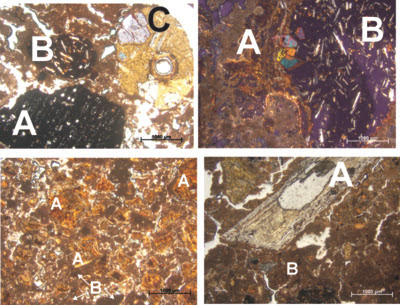Micrograph of the Month - Beautiful Basalt
 These are examples of some of the floor deposits from Margat Castle, Syria (you can see the full thin section in my previous post here). The upper left shows A. a microscopic fragment of charcoal, B. A rounded basalt pebble and B. a rounded weathered basalt pebble, all embedded within a calcitic fabric, most likely a lime based material. The upper right shows a lower portion of the floor, where the inclusions are angular. The 'bubbly' shape of part A. suggest vesicles from vitrification. Part B is the inner unweathered core of basalt. The lower left image shows A. smaller fragments of weathered vitrified granite that appear to have been crushed up and embedded in the B. lime floor matrix. The lower right image shows A. a fragment of highly weathered bone in B. a 'pure' lime floor that overlays all the pebbly floors.
These are examples of some of the floor deposits from Margat Castle, Syria (you can see the full thin section in my previous post here). The upper left shows A. a microscopic fragment of charcoal, B. A rounded basalt pebble and B. a rounded weathered basalt pebble, all embedded within a calcitic fabric, most likely a lime based material. The upper right shows a lower portion of the floor, where the inclusions are angular. The 'bubbly' shape of part A. suggest vesicles from vitrification. Part B is the inner unweathered core of basalt. The lower left image shows A. smaller fragments of weathered vitrified granite that appear to have been crushed up and embedded in the B. lime floor matrix. The lower right image shows A. a fragment of highly weathered bone in B. a 'pure' lime floor that overlays all the pebbly floors.At least, that's what I make of it so far! Might have to enlist the help of a geologist to figure out where the materials are coming from and exactly what processes are going on here, any suggestions? I know the nearest beach consists of basalt sand which would explain the rounded pebbles seen in the upper left, not so sure about the vitrified weathered stuff. Margat Castle itself is constructed from black basalt, not sure where it was quarried though - I can't find much online. Might have to enlist a historian as well!

Comments
Post a Comment